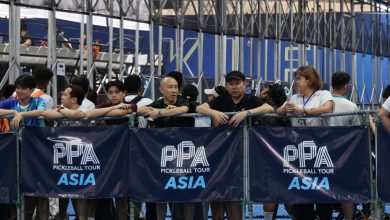PNA Tips: Supercharge Your Pickleball Game with Strength Training

You might have heard that pickleball is for everyone. It is true to a certain extent. Teenagers can play it. So can men and women in their athletic primes (between 22 and 32). But kids can also get into pickleball, and so can the elderly. Just ask Zack “Zack Attack” Muñoz!
Then again, just because pickleball is for everyone doesn’t mean it’s okay to not train for it in some way. If you want to be any good at it, you will need to work on your body to prepare it to excel for your next match and beyond. To this end, you ought to consider strength training as it can help you develop stronger legs, a more stable core, and more powerful arms. In turn, a stable core and strong legs will help you move faster on the court, pivot with ease and force, and maintain balance during those tough rallies. Stronger arms will let you hit those forehands and backhands with more force and speed.
“Due to the size of the court and speed and style of play, pickleball players require a lot of functional flexibility and strength throughout those ranges of motion. Developing strength should be a focus of players’ off-court efforts in order to prevent injury and maximise performance.”
– Joel Watts, personal training leader at Life Time in Charlotte, NC
Strength is essential for pickleball players who want to stay competitive and agile from the first serve to the final point. Plus, it helps preserve bone density and joint health, reducing the risk of fractures and wear-and-tear injuries that could shut you down for extended periods of time. It’s an investment in your body that pays off with every match. Incorporate strength training into your exercise routine two to three times a week — complemented by specific pickleball exercises and cardiovascular workouts — and you’ll see the difference not just in your game, but in your daily life, too.
Crucial to Pickleball Success
Put simply, strength is vital for pickleball players who want to be competitive from the first serve to the final point. It also helps preserve bone density and joint health, which in turn lessens the risk of fractures and wear-and-tear injuries that could sideline you for an extended period. These are the reasons strength training is essentially an investment that you need to make if you want to be a great player. So, look to incorporate it into your lifestyle at least two to three times a week—along with some pickleball-specific exercises. In a few weeks’ time, you’ll see the difference not just in your pickleball game, but also in your daily life!
READ ALSO: Protect Yourself on the Court: Read These Essential Tips to Avoid Pickleball Injuries!
Additionally, research shows that maintaining muscle mass as you age can reduce your risk of injury by up to 60%. It’s partly due to the body needing the right support so it can keep doing the things you love—like playing pickleball.
“Strength training is an essential component of any serious pickleball player’s regimen. By focusing on exercises that build upper body strength, core stability, and lower body power, you’ll be well on your way to dominating the court. Remember, consistency is key, and integrating these strength training tips into your routine will unlock significant improvements in your game. Embrace the journey and enjoy the rewards of a stronger, more agile, and resilient body.”
– Dr Erik Korem, a renowned sports scientist and performance coach with the NFL’s New York Jets
So, are you ready to start off your strength training regimen? Here are some exercises to get you started, as recommended by the PPA Tour and its partner, Mitopure:
Upper Body
- Push-Ups – chest, triceps, shoulders
- Pull-Ups / Assisted Pull-Ups – back, biceps
- Dumbbell Shoulder Press – shoulders, triceps
- Dumbbell Rows or Barbell Rows – upper back, lats, biceps
- Chest Press (Bench or Dumbbell) – chest, triceps
Lower Body
- Squats (Bodyweight or Weighted) – quads, glutes, hamstrings
- Deadlifts (Traditional or Romanian) – hamstrings, glutes, lower back
- Lunges (Walking or Stationary) – quads, glutes, calves
- Glute Bridges or Hip Thrusts – glutes, hamstrings
Core
- Planks (Front and Side) – total core
- Russian Twists – obliques
- Hanging Leg Raises or Lying Leg Lifts – lower abs
- Ab Wheel Rollouts – advanced core strength
Strength Training Tips for the Beginner
Here are some tips to keep in mind as well, also from the PPA Tour:
- Focus on form first and prioritise quality over quantity. Use mirrors or record yourself to check your posture.
- Start with bodyweight or light weights. This is especially important for beginners to avoid injury.
- Use “progressive overload” by gradually increasing weight, reps, or intensity to keep building strength.
- Rest and recovery is important because muscles grow during rest. Allow 48 hours between working the same muscle group.
- Don’t forget to warm up and cool down, including using a dynamic warm-up (e.g., arm circles, light jogging) and a simple cool down with static stretching to increase flexibility and reduce soreness.
- Balance push and pull movements to avoid muscle imbalances by training both anterior and posterior chains.
- Stay consistent—two to four strength sessions per week is great for most people.
- Track your progress by using a journal or app to monitor weights, reps, and improvements.
- Eat well to build strength with an emphasis on protein (1.2–2.0g/kg of bodyweight), complex carbs, and healthy fats.
- Breathe properly by timing your exhale during exertion (lifting) and your inhale during release.
You might feel some discomfort if you’re a total beginner, so make sure to ease yourself into your strength training workouts. Do not rush anything and just let the given tips guide you. Before long, you will find a comfort level in your training sessions that will soon give you the strength and power gains that a consistent strength training program can give.
The key is to get started—and then to keep at it!





